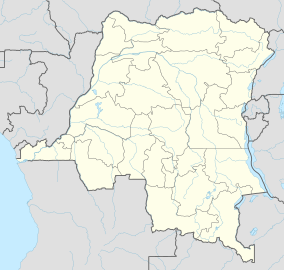Upemba National Park facts for kids
Quick facts for kids Upemba National ParkParc national d'Upemba |
|
|---|---|
|
IUCN Category II (National Park)
|
|
| Location | Haut-Lomami, Lualaba Province, Haut-Katanga Province; Democratic Republic of the Congo |
| Area | 11,730 km2 (4,530 sq mi) |
| Established | 1939 |
| Governing body | l'Institut Congolais pour la Conservation de la Nature (ICCN) |
Upemba National Park (in French: Parc national d'Upemba) is a very large national park. It is located in the southeastern part of the Democratic Republic of Congo. This park is special because it protects many different kinds of plants and animals. It covers parts of the Haut-Lomami, Lualaba, and Haut-Katanga provinces.
Contents
Park Size and Location
Upemba National Park was first created on May 15, 1939. At that time, it was one of the biggest parks in Africa. Its original size was about 17,730 square kilometers (6,846 sq mi).
Later, in July 1975, the park's boundaries were changed. Today, the main part of the park is about 10,000 square kilometers (3,861 sq mi). There is also an extra area of 3,000 square kilometers (1,158 sq mi) connected to it.
Park's Natural Features
The lower part of the park is in an area called the Upemba Depression. This is a green area with many lakes and marshes. One of these is Lake Upemba, which the park is named after. The Lualaba River also flows nearby.
The higher part of the park is in the Kibara Plateau mountains. This area is usually drier than the lower sections.
History of Upemba National Park
Upemba National Park was officially opened in 1939. Since then, people have worked hard to protect its wildlife. However, the park has faced challenges over the years.
Protecting the Park
Like many wildlife areas, Upemba National Park has been threatened by different activities. These include illegal hunting (poaching) and pollution. Sometimes, conflicts in the region have also affected the park.
There are a few small villages located inside the park. Park rangers work hard to protect the animals and the park's natural beauty. These rangers sometimes face dangers while doing their job. For example, in 2004, the park's main office in Lusinga was attacked. Sadly, some rangers and their families were harmed.
In 2005, the people who protect Upemba National Park received a special honor. They won the Abraham Conservation Award. This award recognized their important work in protecting the rich variety of life in the Congo River basin.
More recently, in 2023, the army of the Democratic Republic of Congo worked to secure the park. They carried out an operation against certain groups who were hiding in Upemba and Kundelungu National Parks.
Habitats and Ecosystems
The park has many different types of environments, called habitats. At higher places in the Kibara Mountains, you can find Afromontane grasslands and forests. As you go lower, there are Miombo woodlands and tropical rainforests.
At the lowest points, you will find marshes, wetlands, lakes, and streams. These areas have special plants that grow near water, called riparian zones. The park is home to about 1,800 different kinds of living things. Some of these were only discovered recently.
Lake Upemba and Waterways
Lake Upemba is not very deep, only about 3.2 meters (10.5 ft) at its deepest point. It is a place where a lot of algae grows. The water levels in the park's rivers and lakes change with the seasons. The water is high from March to June and low from October to January.
Many of the watery areas in the park have large swamps. You can find plants like papyrus, Nile lettuce, and water caltrop growing there.
Amazing Animals of Upemba Park
The park's lakes, rivers, swamps, and wetlands are home to many different kinds of fish. There are over 30 species of fish, including types of Cyprinidae, Mormyridae (also known as freshwater elephant fish), Barbus, Alestidae, Mochokidae, and Cichlidae.
Bird Species
Many different bird species live in the park. Some of these birds are rare or in danger of disappearing. These include the unique shoebill, the large wattled crane, and the spotted ground-thrush.
Amphibians
A special type of frog, called Schmidt's snouted frog, is only known to live in Upemba National Park.
See also
- Congo Rainforest
- National parks of the Democratic Republic of the Congo
- List of national parks in Africa


